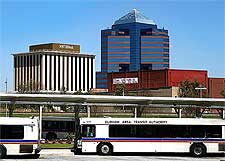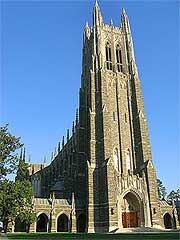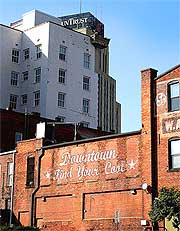Durham History Facts and Timeline
(Durham, North Carolina - NC, USA)

Durham was built on the foundations of an ancient Native American village, giving this early American settlement a head start in terms of infrastructure and trade.
A prime location straddling the northern and southern American states, along with fertile land, helped Durham attract agriculture and manufacturing, leading eventually to its role in North Carolina's cutting-edge Research Triangle cooperative of high-tech cities.
Native American Foundations
Centuries before Europeans arrived in the area, two Native American tribes known as the Occaneechi and the Eno lived where today's Durham sits. Their village was called Adshusheer, a prosperous farming community based right on the important Great Indian Trading Path connecting the various native villages together. This existing infrastructure gave Durham's early history a leg up, as transportation routes and settlement sites were already well-planned and established.

The Colonists
In 1701, explorer John Lawson visited Durham and was impressed enough to name it the 'Flower of the Carolinas' for its scenic beauty. This reputation naturally attracted settlers, a mix of Scots, English and Irish, to the area throughout the mid-1700s. They worked the land and built grist mills. These residents were important players in the early revolutionary movement, and a number even helped to finance further exploration of American's wilds for the likes of Daniel Boone.
Plantation Life
During the 1800s antebellum period in the American South, Durham became home to a number of large plantations such as Cameron, Hardscrabble and Stagville, the latter of which was one of the biggest plantation farms in the entire South by 1860. Although African slavery was a part of these plantations, the slaves contributed to the unique African-American culture and traditions that continue in Durham. Stagville is today one of the main tourist sites showcasing local history.
Big Tobacco
Durham's modern success was built on the popularity of tobacco and the plantations of the wealthy landowner Washington Duke, where tobacco was grown. Several of America's leading tobacco companies were founded right here in Durham. The city's economic prowess in this era attracted other industries, such as textile and denim production.

Washington Duke went on to give back to his home city, establishing the Duke University in 1924. Freed African-American slaves were also an important component of Durham's early social fabric. In 1910, the nation's very first public liberal arts college for African-Americans was opened at the North Carolina Central University by Dr. James Shepard.
Research Giant
During the 1950s and '60s, the economy of Durham took a turn towards research and development, when North Carolina's Research Triangle Park was established, linking the major universities of the area. Along with the cities of
Raleigh and Chapel Hill, Durham became home to dozens of important companies, leading the way of America's modern research sector.
Today, more than 140 major firms and research companies are based in and around Durham, providing one of the main economic boosts to this city.
 Durham was built on the foundations of an ancient Native American village, giving this early American settlement a head start in terms of infrastructure and trade.
Durham was built on the foundations of an ancient Native American village, giving this early American settlement a head start in terms of infrastructure and trade.
 Washington Duke went on to give back to his home city, establishing the Duke University in 1924. Freed African-American slaves were also an important component of Durham's early social fabric. In 1910, the nation's very first public liberal arts college for African-Americans was opened at the North Carolina Central University by Dr. James Shepard.
Washington Duke went on to give back to his home city, establishing the Duke University in 1924. Freed African-American slaves were also an important component of Durham's early social fabric. In 1910, the nation's very first public liberal arts college for African-Americans was opened at the North Carolina Central University by Dr. James Shepard.